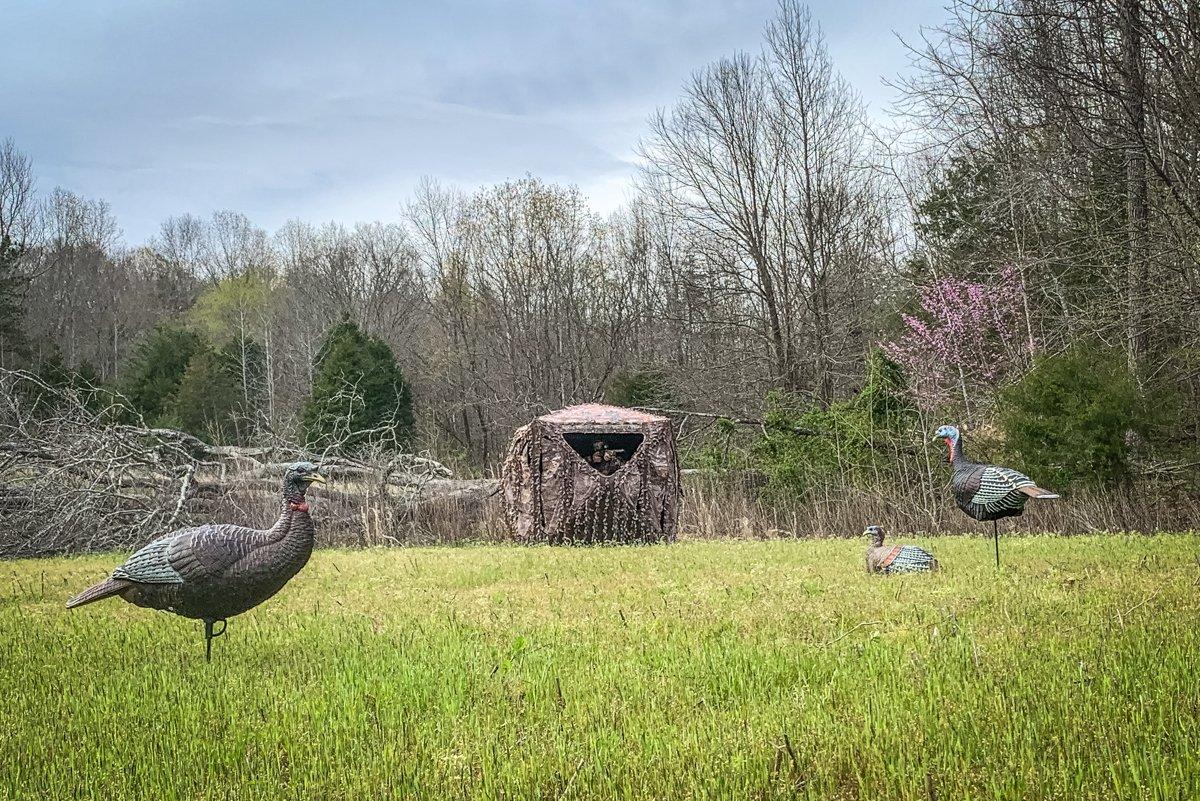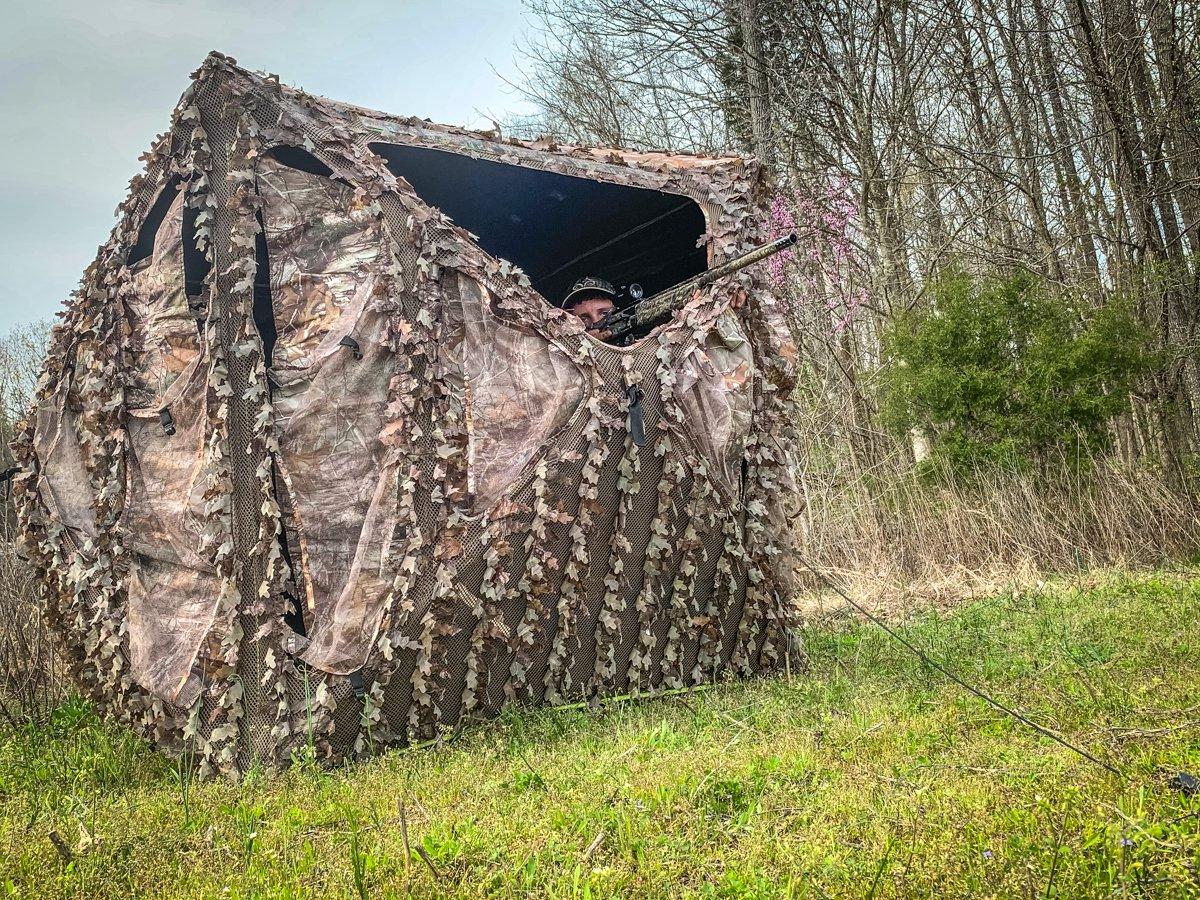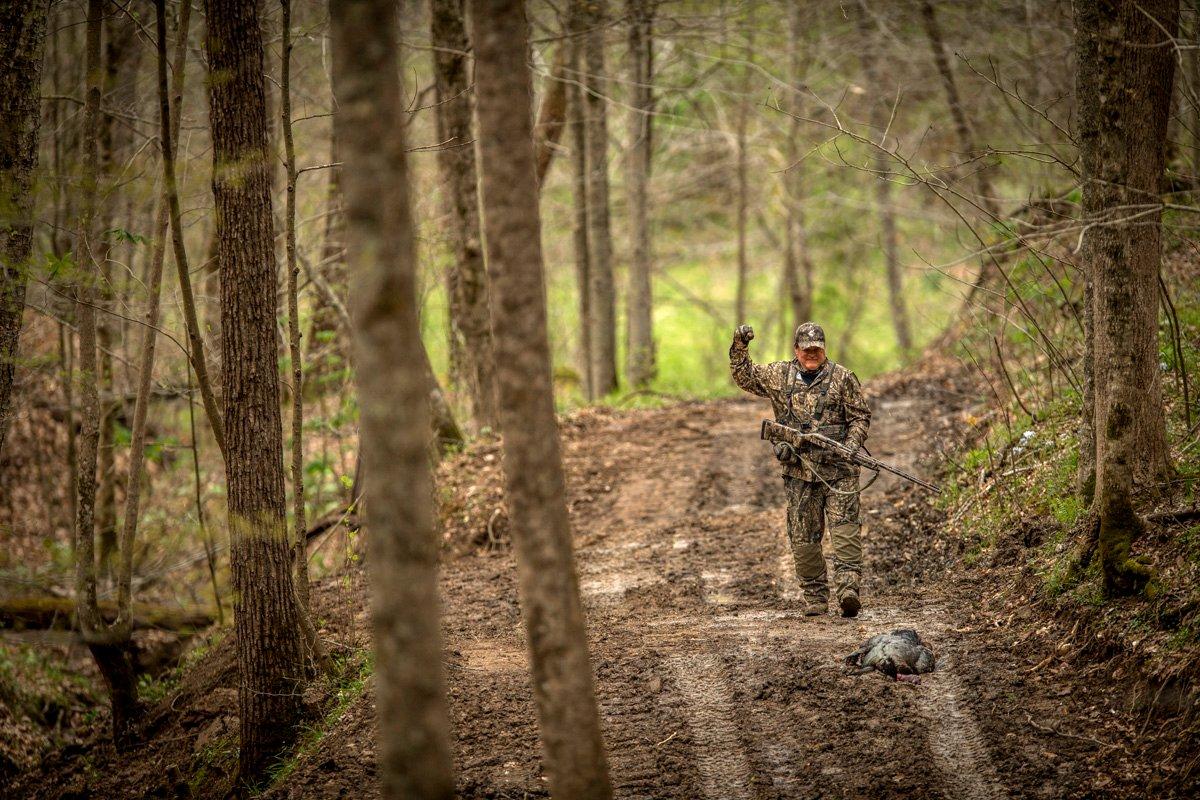It had been a long three hours. We had slipped in well before daylight and popped out a blind along the ridgetop pasture. Our quiet yelps had gone unanswered since sunrise. We knew there were toms in the area; we’d watched them fly up while scouting the evening before, and they had gobbled hard from the roost, just down the ridge, at sunrise. The tracks and droppings that littered the dirt road in front of us told us we were set up in what should be a productive area.
My youngest son, Potroast, craned his neck around to look out the side window of the blind and whispered, There he is! A hundred yards, coming our way. Fast! The big gobbler soon appeared in front of the blind. By that time, he was 60 yards away. He’d seen our decoys, a quarter strut jake and two hens, and was intent on breaking up their party.
Potroast eased his shotgun barrel up to the front window of the blind. The big tom was nearly running now, his beard swinging back and forth with each step. When he hit our decoy setup at 20 yards, he slid to a halt and hit full strut in a single motion. I yelped quietly. The big bird dropped strut and lifted his head to locate the hen he’d just heard. Potroast pulled the trigger.
Blind Faith
Over the past few years, that scene has played out countless times for me, my wife, and our three kids. We started hunting from blinds when the kids were young, but even after they were old enough to sit still next to a tree, we stuck with them. Our area of the state is mostly made up of a patchwork of small farms, many under 50 acres. Many of the places we hunt could be walked in 20 minutes, and if the birds were two farms over while we were there, we left empty-handed.
But since we knew the turkeys would cross the farm we were hunting at some point during the day, we simply adopted the deer stand approach of popping up a blind and waiting. It wasn’t as exciting as the classic run-and-gun approach I grew up with — but it was a good way to kill turkeys on small properties.
Along the way, we started to notice something. Birds like the one described above would often come in silently, never making a gobble after they had flown down from the roost. Other hunters I talked to across the Midwest and Southeast mentioned the same thing. Turkeys just didn’t gobble like they used to.
When I started chasing turkeys back in the mid-80s, Kentucky’s population was on the rise and birds were eager to come to a call. They would gobble at anything that sounded like a yelp, and often come from long distances to investigate what they thought was an interested hen.
But over the last few years, turkey populations have peaked in a lot of areas and started to decline in others. It seems to be harder to get a tom to gobble in the morning, making them tougher to hunt. Those quiet birds were the topic of many a conversation among friends and other turkey hunters we ran into over the course of a season. Were the birds really gobbling less?
Silent Approach
Some experts say they are. Mark Hatfield, wildlife biologist and turkey researcher with the NWTF, says turkeys typically gobble the most after the peak of nesting occurs, when there are fewer available hens to breed. With season openers happening earlier and earlier, particularly in the southeastern U.S., many birds never make it to that point of the season now.
In one 4-year study, we found that up to 60% of the male harvest in some areas occurred before the peak of breeding season, Hatfield says. That means a lot of the gobblers in an area get killed before they would hit their busiest gobbling time of the year.
These early seasons can also alter turkey breeding behavior. Turkeys spend all winter and early spring establishing a pecking order among toms, says Hatfield. The dominant bird in an area is going to do the bulk of the gobbling. When that bird gets taken right at the beginning of breeding season, the next bird in line doesn’t just step up to take his place. The fight to re-establish a new pecking order starts all over, and it might take weeks, or even longer, for a new dominant tom to ascend. If that bird gets killed, it starts over again, meaning season is long over by the time the boss bird in an area would start gobbling.
We did a study where both male birds and cooperating hunters were GPS-tracked throughout the season. What we found was that, while they might not come straight in, birds were going to the exact same spots that hunters were calling from earlier in the day.”
And the turkeys might just be learning, too. Dr. Mike Chamberlain, professor at the Warnell School of Forestry and Natural Resources at the University of Georgia, is one of the leading turkey researchers in the nation. It’s no secret that hunting pressure causes animals to change behavior, he says. Hunted birds are gobbling less often. One study of male turkeys in South Carolina, Georgia and Louisiana found that birds still gobbled well on roost, but birds in areas open to hunting gobbled less frequently on the ground than those in non-hunted populations.
Hunters might even be training birds not to gobble. Turkey hunters naturally target the most aggressive gobbling bird in an area. Over several years, selectively removing these birds has left an older male population of turkeys that have been trained not to gobble. Our data now shows that birds gobble pre- and post season more than in years past, but gobbling activity slows way down during the hunting season, Chamberlain says.
Still, Love is In the Air
While the toms in a given area might not gobble as often as they used to, that doesn’t mean they aren’t interested in finding hens. Over the past several years, we’ve noticed that if we can get a tom to answer us from the roost, sooner or later he will probably swing by to check us out. Dr. Chamberlain says the research bears that out. We did a study where both male birds and cooperating hunters were GPS-tracked throughout the season. What we found was that, while they might not come straight in, birds were going to the exact same spots that hunters were calling from earlier in the day. The bird might fly down and circle the area, it might take 3 or 4 hours to happen, but eventually that gobbler went to where he had heard the hunter’s call earlier in the morning.
If a hunter is patient enough, and if his or her butt can stand it, they can take advantage of this style of hunting simply by finding a good tree, sitting down, and waiting. I’m not that patient, and I’m way too old and out of shape to sit still on the ground for that long.
Our gear setup for this type of hunting consist of a roomy pop-up blind like the Summit Viper, along with a comfortable seat like the ALPS OutdoorZ Folding Chair. Our early season decoy setup includes a quarter- or half-strut jake, a laydown hen and an upright hen. We place the upright hen at 30 yards, and position the jake over the laydown hen about 20 to 25 yards out in front of the blind. The jake should face toward the blind. Most of the time a gobbler will turn his back to the blind to face the decoy, allowing the hunter to position for the shot. Later in the season, after the peak breeding has passed, we leave the jake and laydown hen in the truck and just go with a single upright hen for interest.
I have had the best luck with calling every 15 to 30 minutes, just a few yelps and purrs, to let any nearby toms know I’m in the area. If you can get a hen to answer your calls, try to engage her by repeating the tone and cadence of her calls back to her. Nothing draws in the gobblers like the sound of a pair of hens jawing back and forth at each other. Then, you settle in and wait.
Would I rather strike a hot gobbler along a ridgetop, rush to set up against a nearby tree and call him in? You bet. It’s a more exciting way to hunt. But if you are faced with quiet, pressured birds, or are hunting small properties, then employing the sit and wait approach can be way more effective.
And it sure beats sitting at the house and complaining because the turkeys didn’t gobble that morning.
More Realtree turkey hunting.














